Smart Self-Sensing Composite: Piezoelectric and Magnetostrictive FEA Modeling and Experimental Characterization Using Wireless Detection Systems
Abstract
:1. Introduction
Background
2. Smart Self-Sensing Composite FEA
2.1. Geometry and Boundary Conditions
2.2. Multi-Physics Model
3. Experimental Methodology
3.1. Piezoelectric Solution
3.2. Magnetostrictive Solution
3.3. Compression Molding
3.4. Detection System
4. Results and Discussion
5. Conclusions
- A finite element analysis (FEA) study was conducted to study the mechanical, electrical and magnetic behavior of this composite to characterize its piezoelectric and magnetostrictive self-sensing responses in the presence of applied stress. The electric polarization of the piezoelectric material was found to increase rapidly with increase in strain. High piezoelectric responses were observed at sections of the composites with the highest change in length. The COMSOL Multiphysics® magnetostrictive response was characterized by studying the change in magnetic field around the composite sample. The strain change in the composite sample resulted in a higher magnetization of the composite sample. This increase in magnetization is related to the solid mechanics properties of the material following the Villari effect (i.e., the change in the magnetic susceptibility of a material when subjected to a mechanical stress), therefore showing composite sensitivity to strains.
- Experimental tensile tests of composite samples without any particles, samples with SWCNTs, samples with Terfenol-D nanoparticles and samples with both SWCNTs and Terfenol-D nanoparticles were conducted. It was observed that increase in Terfenol-D nanoparticles volume fraction increases the change in magnetization and, therefore, voltage response up to the point of saturation. The optimum change in amplitude was observed at 0.20% volume fraction of Terfenol-D nanoparticles. A constant ratio of SWCNTs was maintained, and maximum change in electrical resistance was at 7.4%.
- Fracture toughness for the samples with all nanoparticles was explored, and the results showed improved resistance to crack propagation. This is due to the presence of SWCNTs and, therefore, proved that the mechanical properties affected by the presence of Terfenol-D alloys in the composites can be offset by the dispersion of SWCNTs and still maintain the self-sensing property of the composite.
Author Contributions
Funding
Conflicts of Interest
References
- Abbas, M.; Shafiee, M. Structural Health Monitoring (SHM) and Determination of Surface Defects in LargeMetallic Structures using Ultrasonic Guided Waves. Sensors 2018, 18, 3958. [Google Scholar] [CrossRef] [PubMed] [Green Version]
- Reifsnider, K.L.; Case, S.W. Damage Tolerance and Durability of Material Systems; Wiley: Hoboken, NJ, USA, 2002. [Google Scholar]
- Silva, A.J.R. Detection and characterization of defects in composite materials using thermography. Available online: https://www.semanticscholar.org/paper/Detection-and-characterization-of-defects-in-using-Silva/40040968c464d2946985728764f7b457c5781f95#references (accessed on 1 November 2020).
- Light, G.M.; Kwun, H.; Kim, S.; Spinks, R.L. Magnetostrictive sensor for active health monitoring in structures. In Smart Nondestructive Evaluation for Health Monitoring of Structural and Biological Systems; International Society for Optics and Photonics: Bellingham, DC, USA, 2002; Volume 4702, pp. 282–288. [Google Scholar]
- Safri, S.N.A.B.; Sultan, M.T.H.; Jawaid, M. Damage analysis of glass fiber reinforced composites. In Durability and Life Prediction in Biocomposites, Fibre-Reinforced Composites and Hybrid Composites; Elsevier: Amsterdam, The Netherlands, 2018; pp. 133–147. [Google Scholar]
- Wang, H.R.; Long, S.C.; Zhang, X.Q.; Yao, X.H. Study on the delamination behavior of thick composite laminates under low-energy impact. Compos. Struct. 2018, 184, 461–473. [Google Scholar] [CrossRef]
- Ciampa, F.; Mahmoodi, P.; Pinto, F.; Meo, M. Recent advances in active infrared thermography for non-destructive testing of aerospace components. Sensors 2018, 18, 609. [Google Scholar] [CrossRef] [Green Version]
- Rathore, D.K.; Prusty, R.K.; Kumar, D.S.; Ray, B.C. Mechanical performance of CNT-filled glass fiber/epoxy composite in in-situ elevated temperature environments emphasizing the role of cnt content. Compos. Part A Appl. Sci. Manuf. 2016, 84, 364–376. [Google Scholar] [CrossRef]
- Yang, F.; Qian, S. Mechanical and piezoelectric properties of ecc with CNT incorporated through fiber modification. Constr. Build. Mater. 2020, 260, 119717. [Google Scholar] [CrossRef]
- Chen, S.; Luo, J.; Wang, X.; Li, Q.; Zhou, L.; Liu, C.; Feng, C. Fabrication and piezoresistive/piezoelectric sensing characteristics of carbon nanotube/pva/nano-zno flexible composite. Sci. Rep. 2020, 10, 1–12. [Google Scholar] [CrossRef] [PubMed]
- Katabira, K.; Yoshida, Y.; Masuda, A.; Watanabe, A.; Narita, F. Fabrication of Fe-Co magnetostrictive fiber reinforced plastic composites and their sensor performance evaluation. Materials 2018, 11, 406. [Google Scholar] [CrossRef] [Green Version]
- Na, S.M.; Park, J.J.; Jones, N.J.; Werely, N.; Flatau, A.B. Magnetostrictive whisker sensor application of carbon fiber-alfenol composites. Smart Mater. Struct. 2018, 27, 105010. [Google Scholar] [CrossRef]
- Qhobosheane, R.G.; Islam, S.; Elenchezhian, M.R.P.; Vadlamudi, V.; Raihan, R.; Reifsnider, K.; Shen, W. Design of embedded wireless sensors for real-time and in-situ strain sensing of fiber reinforced composites. Struct. Health Monit. 2019. [Google Scholar] [CrossRef]
- Sazonov, E.; Pillay, P.; Li, H.; Curry, D. Self-powered sensors for monitoring of highway bridges. IEEE Sens. J. 2009, 9, 1422–1429. [Google Scholar] [CrossRef] [Green Version]
- COMSOL. The Structural Mechanics Module User’s Guide; COMSOL: Stockholm, Switzerland, 2018. [Google Scholar]
- Rand, A.; Gillette, A.; Bajaj, A. Quadratic serendipity finite elements on polygons using generalized barycentric coordinates. Math. Comput. 2014, 83, 2691–2716. [Google Scholar] [CrossRef] [PubMed] [Green Version]
- Sapra, G.; Sharma, P. Design and analysis of mems mwcnt/epoxy strain sensor using comsol. Pramana J. Phys. 2017, 89, 10. [Google Scholar] [CrossRef]
- Sivakumar, N.; Kanagasabapathy, H.; Srikanth, H.P. Static multiple, distributed piezoelectric actuator structural deformation and bending analysis using comsol. Mater. Today Proc. 2018, 5, 11516–11525. [Google Scholar] [CrossRef]
- Huang, W.; Deng, Z.; Dapino, M.J.; Weng, L.; Wang, B. Electromagnetic-mechanical-thermal fully coupled model for terfenol-d devices. J. Appl. Phys. 2015, 117, 17A915. [Google Scholar] [CrossRef] [Green Version]
- Schwartz, T.J.; Alvandi-tabrizi, Y. Electric control of magnetization in biferroic heterostructures with patterned interfaces: A phase-field micromagnetic study. Available online: https://www.semanticscholar.org/paper/Electric-Control-of-Magnetization-in-Biferroic-with-Tabrizi/352c8dac341eca28c3a7a359e1a7b1e3a68a8cfc (accessed on 15 November 2020).
- Laksar, J.; Sobra, J.; Veg, L. Numerical calculation of the effect of the induction machine load on the air gap magnetic flux density distribution. In Proceedings of the 2017 18th International Scientific Conference on Electric Power Engineering EPE, Kouty nad Desnou, Czech Republic, 17–19 May 2017. [Google Scholar]
- Cao, Q.; Chen, D.; Lu, Q.; Tang, G.; Yan, J.; Zhu, Z.; Xu, B.; Zhao, R.; Zhang, X. Modeling and experiments of a laminated magnetostrictive cantilever beam. Adv. Mech. Eng. 2015, 7, 1687814015573761. [Google Scholar] [CrossRef]
- Federico, S.; Consolo, G.; Valenti, G. Tensor representation of magnetostriction for all crystal classes. Math. Mech. Solids 2019, 24, 2814–2843. [Google Scholar] [CrossRef]
- NASA Technical Reports Server (NTRS). Available online: https://ntrs.nasa.gov/citations/20160006413 (accessed on 12 August 2020).
- Pinto, B.; Kern, S.; Ku-Herrera, J.J.; Yasui, J.; Saponara, L.; Loh, K.J. A comparative study of a self strain-monitoring carbon nanotube film and carbon fibers under flexural loading by electrical resistance changes. In Journal of Physics: Conference Series; IOP Publishing: Bristol, UK, 2015; Volume 628. [Google Scholar]
- Khalid, H.; Nam, I.W.; Choudhry, I.; Zheng, L.; Lee, H.K. Piezoresistive characteristics of CNT fiber-incorporated GFRP composites prepared with diversified fabrication schemes. Compos. Struct. 2018, 203, 835–843. [Google Scholar] [CrossRef]
- Duenas, T.A.; Carman, G.P. Large magnetostrictive response of Terfenol-D resin composites (invited). J. Appl. Phys. 2000, 87, 4696–4701. [Google Scholar] [CrossRef]
- Altin, G.; Ho, K.K.; Carmana, G.P. Static properties of crystallographically aligned Terfenol-D∕polymer composites. J. Appl. Phys. 2006, 101, 033537. [Google Scholar] [CrossRef]
- Kepple, K.L.; Sanborn, G.P.; Lacasse, P.A.; Gruenberg, K.M.; Ready, W.J. Improved fracture toughness of carbon fiber composite functionalized with multi walled carbon nanotubes. Carbon N. Y. 2008, 46, 2026–2033. [Google Scholar] [CrossRef]
- Wang, G.D.; Li, N.; Melly, S.K.; Peng, T.; Li, Y.; Zhao, Q.D.; de Ji, S. Monitoring the drilling process of GFRP laminates with carbon nanotube bucky. Compos. Struct. 2019, 208, 114–126. [Google Scholar] [CrossRef]
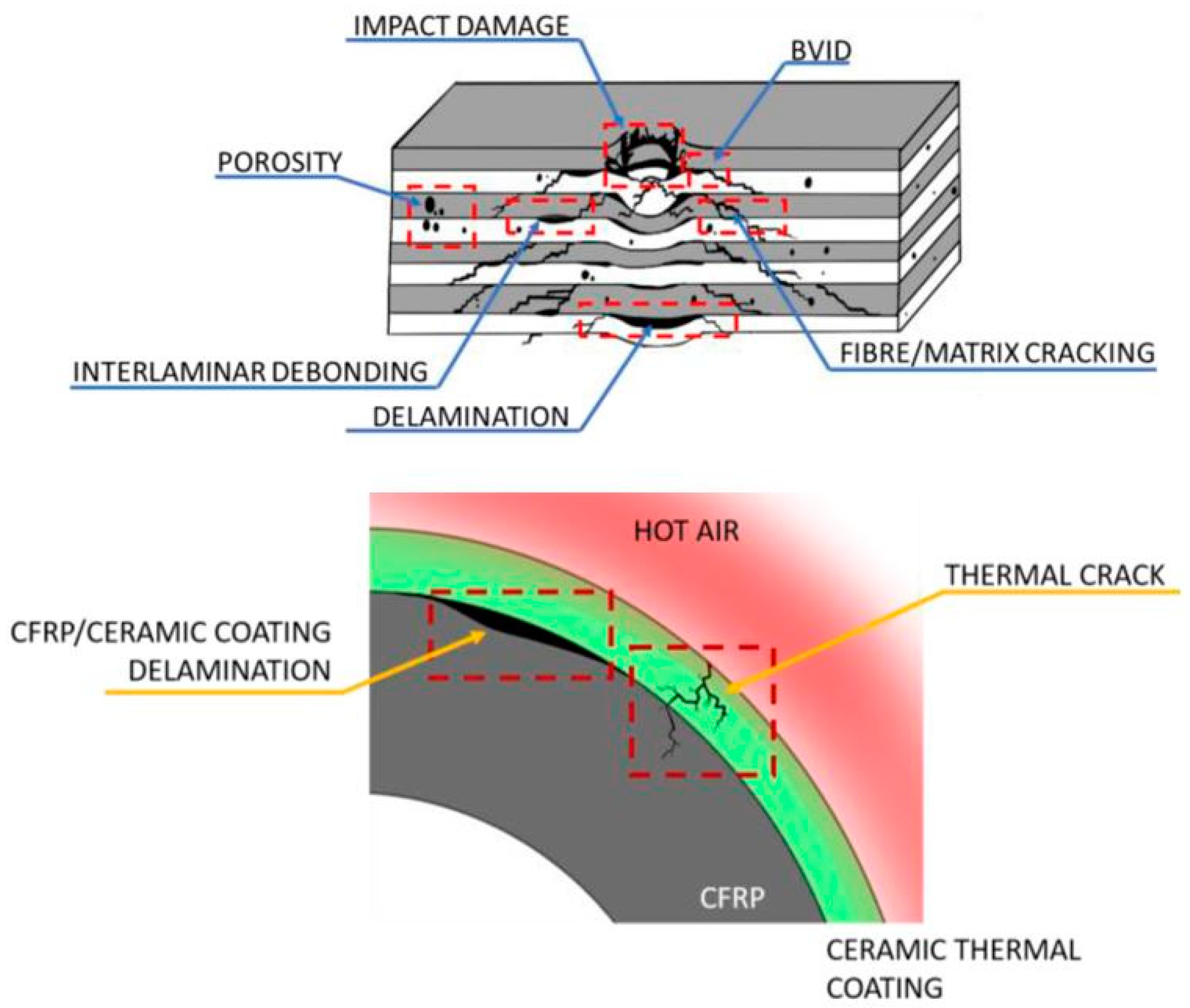
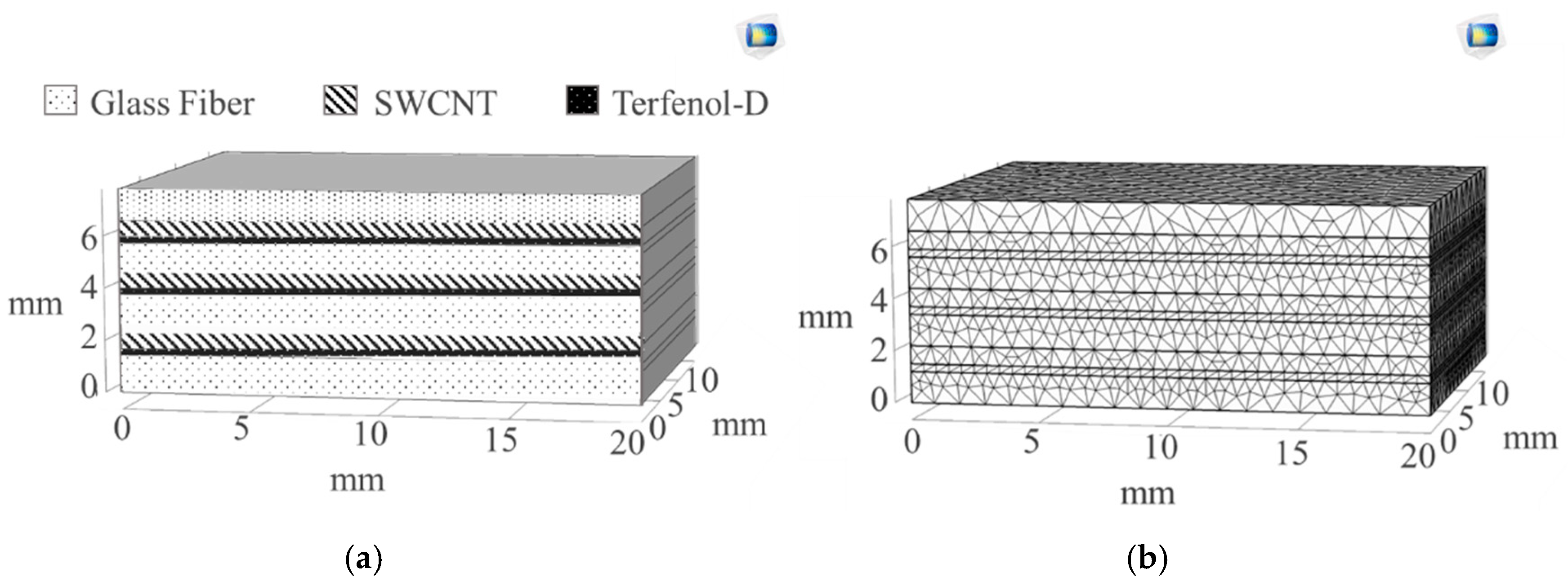


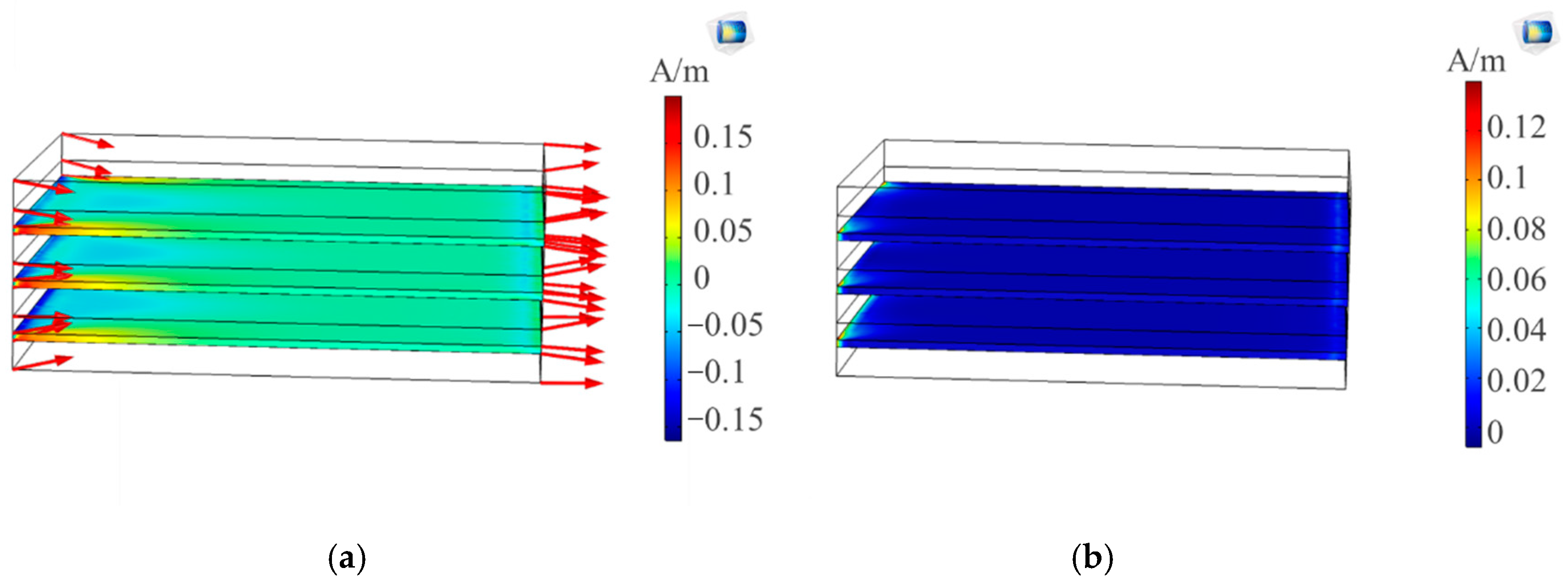









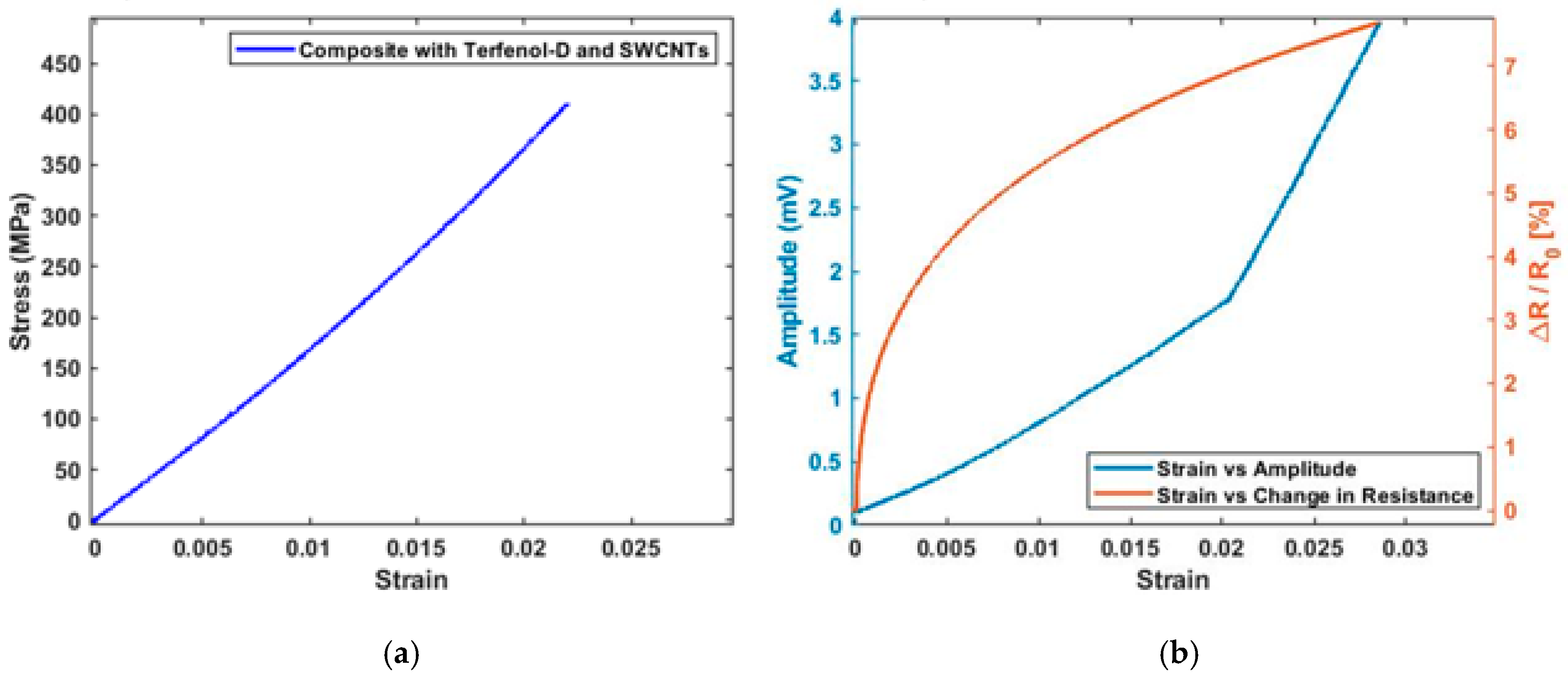


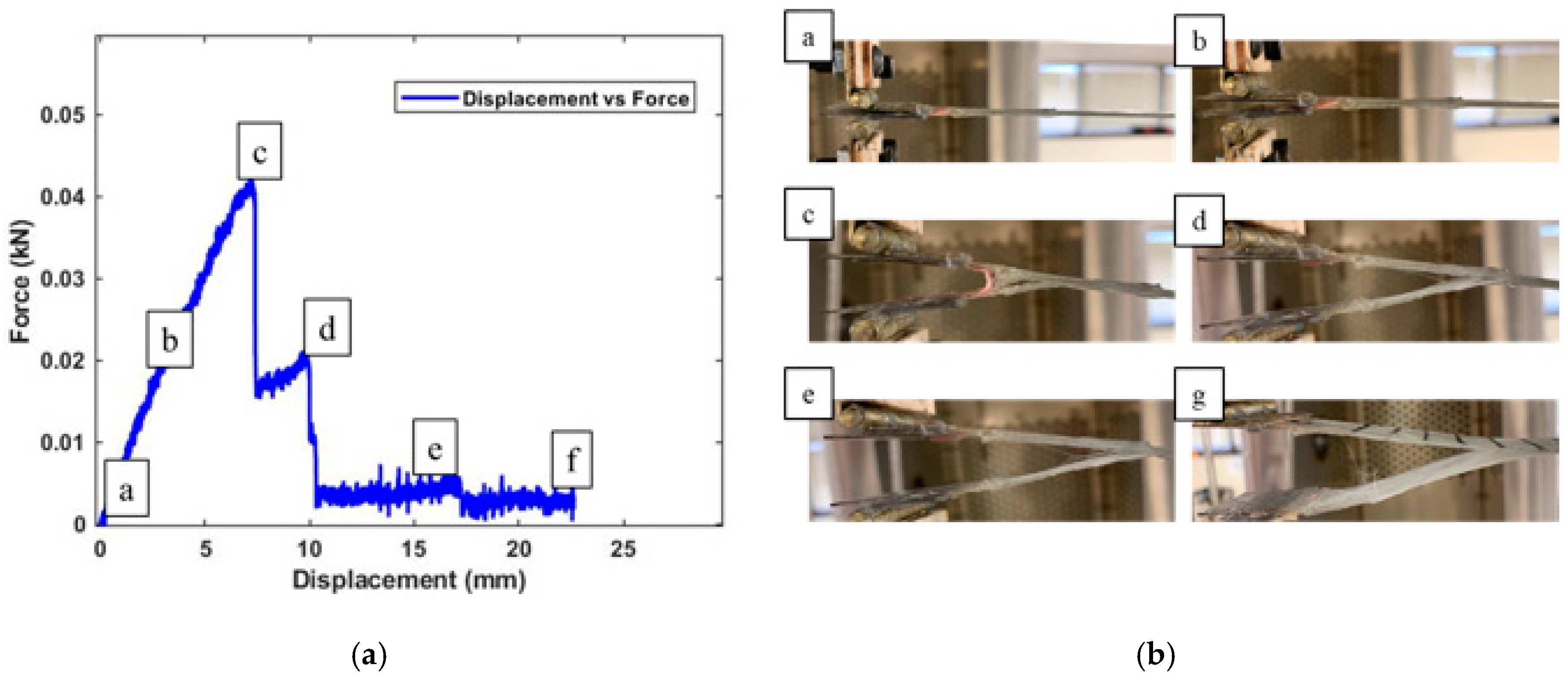
| Property | Unit | Glass Fiber | SWCNT | Terfenol-D |
|---|---|---|---|---|
| Density | g/cc | 2.44 | 1.9 | 9.25 |
| Modulus of Elasticity | GPa | 72.4 | 34.65 | 50–90 |
| Thermal Conductivity | W/(m-K) | 1.3 | 3500 | 13.5 |
| Electrical conductivity | S/m | 1.05 × 10−4 | 106–107 | 1.6667 × 106 |
| Poisson’s ratio | - | 0.20 | 0.311 | 0.5 |
| Relative Permeability | - | 1–4.5 | 100.3 | 2–10 |
| Linear Magnetostriction | ppm | - | - | 800–1200 |
| Specimen | Peak Stress (MPa) | Young’s Modulus (GPa) | Sensitivity |
|---|---|---|---|
| GFRP Experimental | 370 | 22.72 | 0.0457 |
| GFRP/SWCNT Experimental | 385 | 22.85 | 0.0543 |
| GFRP/Terfenol-D Experimental | 361 | 22.31 | 7.243 |
| GFRP/SWCNT/Terfenol-D Experimental | 366 | 22.51 | 6.495 |
| GFRP/SWCNT/Terfenol-D COMSOL | 450 | 23.012 | 7.35 |
Publisher’s Note: MDPI stays neutral with regard to jurisdictional claims in published maps and institutional affiliations. |
© 2020 by the authors. Licensee MDPI, Basel, Switzerland. This article is an open access article distributed under the terms and conditions of the Creative Commons Attribution (CC BY) license (http://creativecommons.org/licenses/by/4.0/).
Share and Cite
Qhobosheane, R.G.; Elenchezhian, M.R.P.; Das, P.P.; Rahman, M.; Rabby, M.M.; Vadlamudi, V.; Reifsnider, K.; Raihan, R. Smart Self-Sensing Composite: Piezoelectric and Magnetostrictive FEA Modeling and Experimental Characterization Using Wireless Detection Systems. Sensors 2020, 20, 6906. https://doi.org/10.3390/s20236906
Qhobosheane RG, Elenchezhian MRP, Das PP, Rahman M, Rabby MM, Vadlamudi V, Reifsnider K, Raihan R. Smart Self-Sensing Composite: Piezoelectric and Magnetostrictive FEA Modeling and Experimental Characterization Using Wireless Detection Systems. Sensors. 2020; 20(23):6906. https://doi.org/10.3390/s20236906
Chicago/Turabian StyleQhobosheane, Relebohile George, Muthu Ram Prabhu Elenchezhian, Partha Pratim Das, Minhazur Rahman, Monjur Morshed Rabby, Vamsee Vadlamudi, Kenneth Reifsnider, and Rassel Raihan. 2020. "Smart Self-Sensing Composite: Piezoelectric and Magnetostrictive FEA Modeling and Experimental Characterization Using Wireless Detection Systems" Sensors 20, no. 23: 6906. https://doi.org/10.3390/s20236906






